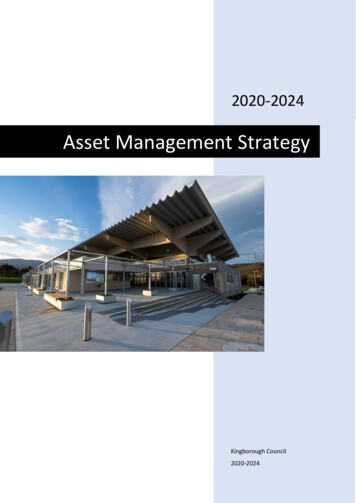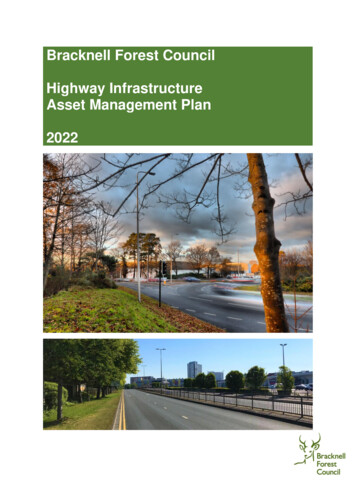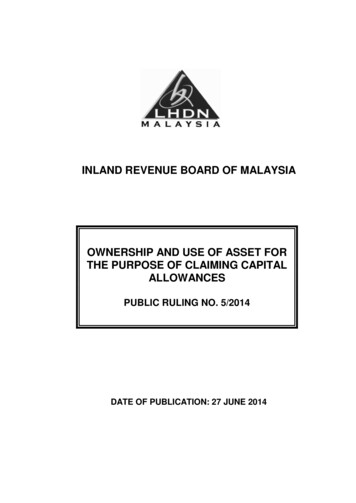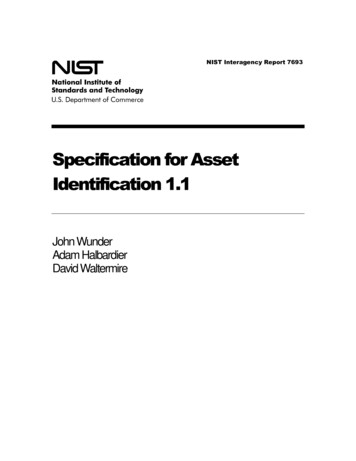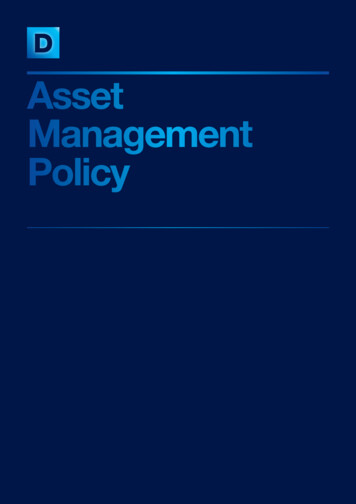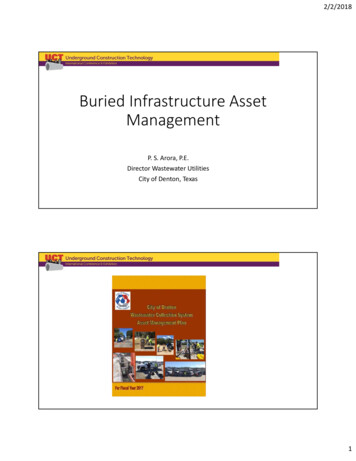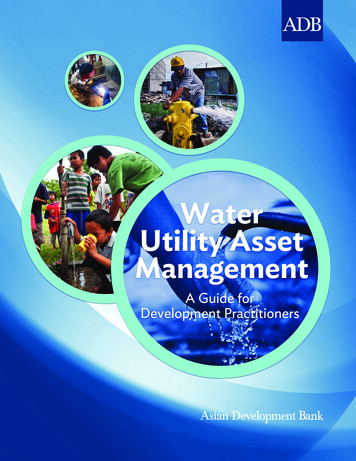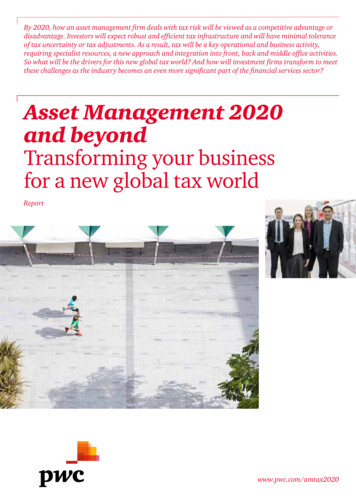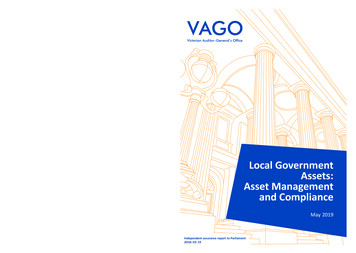
Transcription
—Level 31 / 35 Collins StreetMelbourne Vic 3000T 03 8601 —Local Government Assets: Asset Management and ComplianceVictorian Auditor -General’s OfficeMay 2019Local GovernmentAssets:Asset Managementand ComplianceMay 20192018–19: 1923431 VAGO Local Gov Assets- Asset Man & Compl Cover.pdf Page 1 of 1Independent assurance report to Parliament2018–19: 1923431 VAGO Local Gov Assets- Asset Man & Compl Cover.pdf Page 1 of 1
Local GovernmentAssets: AssetManagement andComplianceIndependent assurance report to ParliamentOrdered to be publishedVICTORIAN GOVERNMENT PRINTERMay 2019PP no 25, Session 2018–19
This report is printed on Monza Recycled paper. Monza Recycled is certified Carbon Neutral by The Carbon Reduction Institute(CRI) in accordance with the global Greenhouse Gas Protocol and ISO 14040 framework. The Lifecycle Analysis for MonzaRecycled is cradle to grave including Scopes 1, 2 and 3. It has FSC Mix Certification combined with 99% recycled content.ISBN 978 1 925678 43 7
The Hon Shaun Leane MLCPresidentLegislative CouncilParliament HouseMelbourneThe Hon Colin Brooks MPSpeakerLegislative AssemblyParliament HouseMelbourneDear Presiding OfficersUnder the provisions of section 16AB of the Audit Act 1994, I transmit my reportLocal Government Assets: Asset Management and Compliance.Yours faithfullyAndrew GreavesAuditor-General23 May 2019
ContentsAudit summary . 7Conclusion .7Findings.8Recommendations .11Responses to recommendations .111 Audit context . 131.11.21.31.41.51.61.71.8Background .13Roles and responsibilities .14Legislation .15Frameworks and guidance. 15Using asset information .17Why this audit is important .20What this audit examined and how .21Report structure .222 Managing asset information . 232.12.22.32.42.52.6Conclusion .23Asset information governance arrangements .23Identifying asset information needs .24Asset information management processes .26Accuracy and completeness of asset information .29Asset information management systems .313 Using asset information . 353.13.23.33.43.5Conclusion .35Asset management governance .35Asset planning and decision‐making .37Asset risk informing investment decisions .38Comparison of audit findings with NAMAF .39Appendix A. Audit Act 1994 section 16—submissions and comments . 41Appendix B. Maturity assessments . 53Victorian Auditor‐General’s ReportLocal Government Assets: Asset Management and Compliance5
Acronyms6AIMSasset information management systemALGAAustralian Local Government AssociationAMAFAsset Management Accountability FrameworkAMPasset management planDELWPDepartment of Environment, Land, Water and PlanningDRFADisaster Recovery Funding ArrangementsDTFDepartment of Treasury and FinanceIIMMInternational Infrastructure Management ManualISOInternational Organization for StandardizationLG ActLocal Government Act 1989LGPMCLocal Government and Planning Ministers' CouncilLGVLocal Government VictoriaMAVMunicipal Association of VictoriaNAMAFNational Asset Management Assessment FrameworkNDRRANatural Disaster Relief and Recovery ArrangementsRM ActRoad Management Act 2004SAMPStrategic Asset Management PlanVAGOVictorian Auditor‐General’s OfficeVGCVictoria Grants CommissionLocal Government Assets: Asset Management and ComplianceVictorian Auditor‐General’s Report
Audit summaryOne way in which local councils deliver services to the community is througheffective use of their assets. Council assets include roads, bridges, footpaths,drains, libraries, town halls, parks, recreational centres, and other communityfacilities. The 79 Victorian councils control more than 102.1 billion in assetsand infrastructure, including 26.5 billion in roads and bridges and 8.7 billion indrains.To ensure they realise full value from these assets, councils need to effectivelyplan for, manage, and utilise them. Effective management of these assetsrequires the collection of appropriate information, including their value, cost tomaintain and operate, condition, performance, risk and utilisation. Councilsshould then use this information to make decisions about their assets. Theseasset management decisions include how and when to invest in new assets, aswell as decisions about maintenance, replacement, upgrades, and disposals.This audit assessed whether local councils accurately document infrastructureassets in their information systems and use this information in their assetmanagement and planning.The audit focused on five local councils:Conclusion Colac Otway Shire Council (Colac Otway) Darebin City Council (Darebin) Hindmarsh Shire Council (Hindmarsh) Mildura Rural City Council (Mildura) Nillumbik Shire Council (Nillumbik).The audited councils do not have enough comprehensive and accurateinformation to support asset planning, and they do not make enough use of theinformation that they have. Although they maintain basic data about theirassets—such as location and description—councils do not always supplementthis with asset maintenance and failure data. This reduces their ability toidentify poor performing assets and to justify new asset investments.Councils use some asset information to support asset planning and decision‐making, however, this is not consistent across all asset classes and councils. Forexample, all audited councils have and use better information about their roadsthan other asset classes, largely due to their obligations under the RoadManagement Act 2004 (RM Act).Complex and unintegrated asset information management systems (AIMS)compound the information gaps, which make it difficult for staff to find theasset information they need to support decision‐making. This means assetdecisions depend heavily on the experience and judgement of individual staffwithout the benefit of objective data.Victorian Auditor‐General’s ReportLocal Government Assets: Asset Management and Compliance7
FindingsManaging asset informationAsset management policy, governance, and rolesAll audited councils have governance arrangements for asset informationmanagement within their asset management policies, although Darebin andColac Otway could improve this by clarifying roles and responsibilities. In anexample of better practice, Nillumbik has a data framework that outlines theinformation the council will collect against each type of asset. Mildura isdeveloping similar guidelines.Identifying asset information needsNone of the audited councils have comprehensively documented their assetinformation needs. However, all audited councils have asset management plans(AMP)—either final or draft—that identify and prioritise asset informationneeds for roads and related infrastructure—such as traffic control signs andstreet lights.Essential safety measuresare the features of publicbuildings that ensure thesafety of occupants, suchas fire doors, alarmsystems, fire extinguishersand emergency lighting.Under the DisasterRecovery FundingArrangements, theAustralian Governmentcan give funding to stateand local governmentsafter a natural disaster torepair assets. To satisfyclaims for this funding,councils need informationabout the pre‐disasterfunction and condition ofassets.Councils need to identify and document their legal obligations about assetinformation to ensure that they collect the right type of information. ColacOtway, Mildura and Nillumbik have done this—their AMPs refer to relevantregulatory and statutory requirements. In contrast, Hindmarsh has not fullydocumented its obligations and Darebin has only noted its legal obligationsabout roads information.Except Nillumbik, the audited councils keep information about essential safetymeasures and asbestos registers separate from their standard AIMS. Notkeeping this information in a central and accessible location makes it difficult forcouncil staff to find and update the information when they need to.None of the audited councils have identified the asset information they need tosupport claims for funding under the Disaster Recovery Funding Arrangements(DRFA). As a result, councils risk not having the right information to satisfyclaims for funding in the event of a natural disaster.Information management processesDocumenting new assetsNillumbik, Hindmarsh and Mildura have documented processes for recordingnew asset information. In contrast, Colac Otway and Darebin advise that theysometimes record information about new assets as they find them, for exampleduring condition inspections.Asset handover occurs when teams within a council transfer responsibility for anasset, such as when a new asset transfers from the construction team to theteam responsible for operating the asset. Ineffective asset handover processescan affect data quality. For example, Colac Otway advised that during fire andflood recovery work, its asset handover process failed—the council acquirednew assets but did not record them in its AIMS. This means the council's assetinformation was not complete and up‐to‐date at that time.8Local Government Assets: Asset Management and ComplianceVictorian Auditor‐General’s Report
Asset maintenance and failure informationThe maintenance and failure history of an asset helps councils to predict thelikelihood of future failures or performance issues. None of the audited councilshave documented processes to capture this information and, as a result, havemissed opportunities to use maintenance data to inform decisions aboutoperational and capital planning. For example, councils do not record the cost ofmaintenance works against specific road assets. This means they can only accessthe overall cost of their road maintenance program and cannot analyse the costof maintaining each road.Similarly, except for Darebin, the audited councils link maintenance data tobuildings, rather than to component assets—such as air conditioner units orgenerators. This means councils must use an overall average of a building’scondition to predict future maintenance and renewal costs. This is ineffective, ascomponent assets may require renewal or replacement at different times.Accuracy and completeness of asset informationWe asked councils to self‐assess the completeness of their asset information aswell as their confidence in it. We then tested the assessments by reviewing asample of asset records from roads, stormwater and building asset classes.Based on this process, Nillumbik has the highest completeness across all assetclasses, with an average completeness of 89 per cent, compared with anaverage of 41 per cent across the remaining audited councils. The auditedcouncils have a greater proportion of complete data on their road and relatedassets—an average of 67 per cent across the councils—than other asset classes.Councils need to be confident that their asset information is accurate andcomplete, so that they can use it to make evidence‐based decisions. ExceptNillumbik, the audited councils had low confidence that their asset informationwas accurate and complete. The audited councils had more confidence in theirroads data than in their other asset classes—they had high confidence in theinformation for 45 per cent of their road assets. In contrast, the audited councilshad high confidence in only 25 per cent of building assets, 20 per cent of drains,bridges and culverts and 18 per cent of recreation assets—such as sportingfields, playgrounds, and trees.Nillumbik had higher confidence in its recreational asset information because ithad identified and documented these assets in its Reserves Asset ManagementPlan.Asset information management systemsAIMS are software applications for capturing, managing and analysing assetinformation. Ideally, a council's AIMS should comprise a small number ofintegrated core software products.Victorian Auditor‐General’s ReportLocal Government Assets: Asset Management and Compliance9
Except Mildura, the audited councils have complex AIMS and use multiplesoftware applications to manage their asset information, which are not wellintegrated. In addition, Hindmarsh and Colac Otway have limiteddocumentation on how to use or manage their applications. This can lead tocouncil staff manually transferring data from one application to another,resulting in inefficiencies and potential errors.In 2014, Mildura purchased and began implementing a new AIMS. The systemrepresents better practice in that it links to the council's customer relationshipmanagement system, geographic information systems and, through a manualexport process, its finance system. Although it requires further effort to fullyimplement and transfer information into the system, the council has establisheda project control group to oversee its implementation and progressively improvethe system.Using asset informationCapital and operational planningRelying on staff judgement to make decisions about assets—rather than assetinformation and documented processes—creates a risk that councils will notmake evidence‐based decisions. Darebin, Hindmarsh and Mildura rely heavilyon council staff experience when making asset management decisions, and donot always document these decisions.None of the audited councils have sufficient documentation on capital planningprocesses to adequately support evidence‐based asset management for allasset classes, and over the asset lifecycle. Nillumbik, Mildura and Darebin areapplying some processes to use asset data and information to inform capitalplans, especially relating to roads and related infrastructure and drainage.Similarly, none of the audited councils have sufficiently documented theiroperational planning processes, although Colac Otway and Hindmarsh use somemaintenance and operational cost data to inform operational plans andbudgets. The other three councils—Nillumbik, Mildura, and Darebin—only useprevious historical maintenance costs for developing their annual maintenancebudgets. These councils have recognised a gap in their processes and advisethey are working on projects to rectify the issue.Using asset riskNone of the audited councils consistently use risk information in theirdecision‐making across all asset classes, though all use more risk informationwhen planning for road and drainage assets.Audited councils do not have formal processes for assessing which assets arecritical or important to service delivery, which would help them prioritiseinvestment and works activities. Despite a lack of processes, all audited councilsexcept Colac Otway use risk assessment to identify critical drains.10Local Government Assets: Asset Management and ComplianceVictorian Auditor‐General’s Report
Asset management capability and resourcesNone of the audited councils’ resource capability plans identify a need for skillsin analysing asset information. In addition, none have established clear rolesand responsibilities for the use of asset information in asset planning anddecision‐making. Without this, councils cannot be sure they have the skillsavailable to use asset information to support decision‐making about assets.RecommendationsWe recommend that Victorian councils:1. revise their governance and policy guidance for asset investmentdecision‐making to ensure that it is evidence‐based (see Section 3.2)Responses torecommendations2.clearly determine and document the information that they need foreffective asset reporting and decision‐making, including ensuring DisasterRecovery Funding Arrangements needs are met (see Section 2.3)3.establish more consistent and systematic processes for data collection on allasset classes to a level commensurate to the criticality of the asset andimplement them to collect the information (see Section 2.4)4.integrate asset management information systems so staff can easily recordand access data to enable analysis for planning and decision‐making(see Section 2.6)5.identify their critical assets, and the potential risks of their failure, to informinvestment priorities (see Section 3.4)6.integrate asset management planning into financial planning cycles andprocesses to ensure councils balance asset investment needs against theirobjectives and funding constraints (see Section 3.3)7.evaluate their capability, including resources, skills and training to meettheir identified asset management needs, potentially using the NationalAsset Management Assessment Framework (see Sections 3.2 and 3.5).We have consulted with the audited councils and we considered their viewswhen reaching our audit conclusions. As required by section 16(3) of the AuditAct 1994, we gave a draft copy of this report to the councils and asked for theirsubmissions or comments. We also provided a copy of the report to theDepartment of Premier and Cabinet.All audited councils have accepted the recommendations from this audit.Councils’ full responses are included in Appendix A.Victorian Auditor‐General’s ReportLocal Government Assets: Asset Management and Compliance11
Audit context1.1 BackgroundOne way in which local councils deliver services to the community is througheffective use of their assets. Council assets typically include roads, bridges,footpaths, drains, libraries, town halls and recreational centres, and mayinclude other specialised facilities such as airports and landfills. The 79 Victoriancouncils control more than 102.1 billion in assets and infrastructure, including 26.5 billion in roads and bridges and 8.7 billion in drains, as shown inFigure 1A.Figure 1AVictorian local government assets ( billion), 2017–180.81Land3.553.80Roads and bridges8.73Building, plant and equipment10.5748.17DrainageParks and footpaths26.49Other infrastructure assetsOtherNote: ‘Other infrastructure assets’ includes works in progress, waste management, recreationalfacilities, aerodromes, and car parks.Note: ‘Other’ includes investment property and other intangible and financial assets.Source: VAGO, based on council annual reports.To ensure they realise maximum value from their assets, councils need tomanage and utilise them effectively. Asset management is the systematicprocess that guides the planning, acquisition, operations, maintenance, andeventual replacement or disposal of assets. Its purpose is to ensure councils’assets allow them to deliver services that meet community standards and needsefficiently, while managing risks.Victorian Auditor‐General’s ReportLocal Government Assets: Asset Management and Compliance13
Effective asset management includes collecting appropriate information andusing it to make decisions on planning and managing assets. The types ofinformation for councils to collect include asset value, cost to operate andmaintain, condition, maintenance, performance, risk, and utilisation.1.2 Roles andresponsibilitiesMultiple government agencies and associations provide information andguidance to the local government sector to support councils’ asset managementactivities.Local Government VictoriaLocal Government Victoria (LGV)—a division of the Department of Environment,Land, Water and Planning (DELWP)—provides advice and support to councils toimprove their business and governance practices, including asset management.Its objectives include the development and implementation of evidence‐basedpolicy and projects that strengthen councils’ capacity to meet the needs ofVictorian communities.Guidelines released to support better asset management practice include: Local Government Asset Management: Better Practice Guide (2015) Good Practice Guide for Asset Protection Permits in Local Government(2013) Local Government Asset Investment Guidelines (2006) Guidelines for Measuring and Reporting the Condition of Road Assets (2006) Guidelines for Developing an Asset Management Policy, Strategy and Plan(2004) Sustaining Local Assets: Local Government Asset Management PolicyStatement (2003).Municipal Association of VictoriaThe Municipal Association of Victoria (MAV) runs the STEP Asset Managementand Financial Sustainability Program, which it has designed to help councilsimprove their asset management processes with support from assetmanagement consultants. The STEP program uses the National AssetManagement Assessment Framework (NAMAF) (discussed in Section 1.4) as abasis for assessing councils’ asset management performance.Victoria Grants CommissionVictoria Grants Commission (VGC), supported by DELWP, allocates financialassistance grants from the Australian Government to Victorian councils.It collects data on a range of asset‐related matters, including capital assets andoutlays, valuations, and road inventory expenditure.14Local Government Assets: Asset Management and ComplianceVictorian Auditor‐General’s Report
1.3 LegislationSection 140(2) of the Local Government Act 1989 (LG Act) requires councils toensure they have adequate control over their assets. Further, section 136 of theLG Act requires councils to manage their financial risks prudently, having regardto economic circumstances, including the management and maintenance ofassets. Unlike the Financial Management Act 1994, which does not apply tocouncils, there is no explicit obligation under the LG Act for councils to maintainan asset register.The previous government introduced the Local Government Bill 2018 in theParliament in May 2018. If enacted, it would have replaced the current LG Act.The Bill proposed a requirement for a 10‐year AMP as well as a 10‐year financialplan and a four‐year budget. These changes aimed to encourage councils toconsider short, medium, and longer‐term approaches to asset management andresource planning. In the lead up to the 2018 state election, the Bill lapsed,leaving the LG Act as the legal framework for Victorian local government.A range of applicable legislation covers aspects concerning council‐ownedassets. Some of these include:1.4 Frameworksand guidance Road Management Act 2004—local roads are one of the most significantasset classes that councils own, representing more than a quarter of thetotal value of Victorian council assets. Under the RM Act, councils mustmaintain a register of all public roads for which they are the coordinatingroad authority. Occupational Health and Safety Act 2004—promotes improved standardsfor occupational health, safety, and welfare. It places obligations on councilsto provide a safe working environment for their employees and to ensurethat councils maintain their plant and equipment in a manner that is safeand fit for purpose. Building Regulations 2018—as owners of public buildings, councils mustkeep records of maintenance checks, service and repair works for essentialsafety measures (such as fire alarms and emergency lighting).Councils can access guidance on asset management and asset information froma range of sources.National Asset Management Assessment FrameworkSince 2010, Victorian councils have self‐assessed against NAMAF, developed bythe Australian Centre of Excellence for Local Government. NAMAF consists of11 key asset management elements, including councils’ asset data and systems.Asset Management Accountability FrameworkThe Department of Treasury and Finance's (DTF) Asset ManagementAccountability Framework (AMAF)—applicable to Victorian Governmentagencies—outlines requirements over four key stages of the asset managementlifecycle, from planning, acquisition, operation, and maintenance, to disposal.Victorian Auditor‐General’s ReportLocal Government Assets: Asset Management and Compliance15
The AMAF, although not compulsory for Victorian councils, provides usefulguidance on how councils can manage their asset information. The AMAF setsout that agencies must maintain asset information—both financial and non‐financial—to support asset planning, and performance monitoring andreporting.ISO 55000 Asset ManagementThe International Organization for Standardization's ISO 55000:2014 AssetManagement (ISO 55000) provides a global guide to better practice in assetmanagement, including asset information management.ISO 55000 specifies that entities should align information requirements to assetmanagement needs and risks, along with requirements for collecting, managing,evaluating, and ensuring consistency and availability of information for assetmanagement decision‐making.ISO 55000 identifies several requirements for sound asset information. Theseare summarised in Figure 1B.Figure 1BElements of sound asset informationElementDescriptionInformation governanceDefine roles and responsibilities for managing assetinformation and processes to ensure asset information issuitable to achieve council objectives.Information requirementsIdentify the asset information needed to support: asset management functions asset management systems the council's objectives legal and regulatory requirements.Better practice is to capture this in a strategy, including actionsto improve the asset information over time.Information managementFormalise processes for managing asset information. Theprocesses should ensure that information is available andsuitable for councils’ needs. They will describe how councilscollect, analyse and evaluate information. Asset informationshould have appropriate coverage and accuracy, and beconsistent with other data held by councils.Information systemsEnsure capability to store, manage, access, analyse and shareinformation for asset management, planning anddecision‐making purposes. Councils make continualimprovements for ongoing adequacy and effectiveness.Source: VAGO, based on ISO 55001:2014.16Local Government Assets: Asset Management and ComplianceVictorian Auditor‐General’s Report
Institute of Public Works Engineering AustralasiaThe Institute of Public Works Engineering Australasia has released materialssince 1994 designed to support asset management processes and AMPdevelopment. These materials, which provide guidance on asset managementinformation and its use in planning, include:1.5 Using assetinformation International Infrastructure Management Manual (IIMM) Australian Infrastructure Financial Management Manual.There are three key types of asset information, as shown in Figure 1C.Figure 1CTypes of asset informationSource: VAGO.Asset management and planningAsset information, including the asset's condition, is essential to support a rangeof important council decisions. Councils should use their asset information indeveloping their long‐term strategic and financial plans.A 2016 Queensland Audit Office report found that, due to inaccurate andincomplete asset condition data, councils were undertaking asset renewals in anunstructured and reactive manner. The report noted that this limited theirunderstanding of the level at which to set council rates and charges and how tooptimise the life of the assets.Similarly, a 2017 report by the Controller and Auditor‐General of New Zealandhighlighted that high‐quality asset information improved councils’ longer‐termplanning.Victorian Auditor‐General’s ReportLocal Government Assets: Asset Management and Compliance17
Figure 1D shows the Victorian local government sector's renewal gap—thedifference between what a council spends on renewing, restoring or replacingexisting assets and its depreciation costs—over the past four years.Figure 1DAsset renewal expenditure as a percentage of depreciation, 2014–15 to 2017–18
Level 31 / 35 Collins Street Melbourne Vic 3000 T 03 8601 7000 enquiries@audit.vic.gov.au www.audit.vic.gov.au — — Victorian Auditor-General's Office
